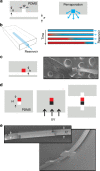Engineering polymer MEMS using combined microfluidic pervaporation and micro-molding
- PMID: 31057903
- PMCID: PMC6220165
- DOI: 10.1038/s41378-018-0017-2
Engineering polymer MEMS using combined microfluidic pervaporation and micro-molding
Abstract
In view of the extensive increase of flexible devices and wearable electronics, the development of polymer micro-electro-mechanical systems (MEMS) is becoming more and more important since their potential to meet the multiple needs for sensing applications in flexible electronics is now clearly established. Nevertheless, polymer micromachining for MEMS applications is not yet as mature as its silicon counterpart, and innovative microfabrication techniques are still expected. We show in the present work an emerging and versatile microfabrication method to produce arbitrary organic, spatially resolved multilayer micro-structures, starting from dilute inks, and with possibly a large choice of materials. This approach consists in extending classical microfluidic pervaporation combined with MIcro-Molding In Capillaries. To illustrate the potential of this technique, bilayer polymer double-clamped resonators with integrated piezoresistive readout have been fabricated, characterized, and applied to humidity sensing. The present work opens new opportunities for the conception and integration of polymers in MEMS.
Conflict of interest statement
The authors declare that they have no conflict of interest.
Figures



References
-
- Lui C. Recent developments in polymer MEMS. Adv. Mater. 2007;19:3783. doi: 10.1002/adma.200701709. - DOI
-
- Srinivasan, A., Bandyopadhyay, S. Advances in Polymer Materials and Technology (Taylor & Francis, CRC Press, Boca Ranton, FL, USA, 2016).
-
- Villanueva LG, Bausells J, Brugger J. Grand challenge in N/MEMS. Front. Mech. Eng. 2016;1:15. doi: 10.3389/fmech.2015.00015. - DOI
-
- Kim BJ, Meng E. Review of polymer MEMS micromachining. J. Micromech. Microeng. 2016;26:013001. doi: 10.1088/0960-1317/26/1/013001. - DOI
LinkOut - more resources
Full Text Sources
